The Mangrove Swamp Rice Production System of Guinea Bissau: Identification of the Main Constraints Associated with Soil Salinity and Rainfall Variability
Abstract
1. Introduction
2. Rice Production in Guinea-Bissau
2.1. Rice Production Systems in GB
2.2. MSRP and Typologies of Fields
2.3. Areas and Yields
2.4. Rice Crop Species and Varieties
| Years | 1948–1973 | 1974–1990 | 1991–2010 | 2011–2023 | |||
|---|---|---|---|---|---|---|---|
| Varieties |
|
|
|
|
|
|
|
| References | [16,54,75,82,84] | [25,71,76,80,83,85] | [19,25,26,65,79,86] | [21,25,39,81] | |||
3. Salinity and Salt Management in the MSRPS in GB
3.1. Base Concepts
3.2. Salinity in the Bolanhas of the MSRPS
3.3. Salinity and Water Productivity in the MSRPS
4. General Soil Properties, Taxonomy, and Topography in MSR Fields
4.1. Soil Taxonomy in Associated Tidal Mangrove Fields and Tidal Mangrove Terraces
4.2. Acidity Formation in Tidal Mangrove Soils
5. Rainfall Patterns and Farmers’ Agronomic Practices Related to Water Management in the MSRPS
The Use of Dikes, Bunds and Rigdes for Water Management in the Paddies
6. Key Issues Overview and Future Research
- A wide range of rice varieties with different names found in the MSRPS. Understanding the characteristics of each variety, particularly in terms of salt tolerance, could improve agronomic recommendations at the national level.
- A lack of understanding of water dynamics in the MSRPS. This knowledge, obtained from field measurements and modelling, could facilitate the efficient planning of rice production cycles while minimizing problems related to toxicity and salinity.
- A lack of knowledge about the salt balance, especially regarding the initial and final salinity conditions in different contexts. The development of a tool that allows to assess the hydro–saline balance in the MSRP is crucial to optimize the cultivation calendar for the timely start of each rice production season.
- Limited information on soil fertility, nutrient dynamics, and their relationship to MSRPS productivity. Comprehensive chemical characterization of the soil and an understanding of nutrient dynamics could improve on-site nutrient management.
- No information regarding the spatialization of physicochemical properties in swamp fields (“bolanhas”). Spatial mapping of soil properties could help identify areas with higher fertility, salinity, and the potential for improving rice productivity.
- Insufficient studies on plasticity related to adequate soil moisture at the beginning of farming operations. Generating maps in this regard could provide farmers with valuable tools, allowing them to prioritize sites with optimal conditions for soil tillage. The companion article by Garbanzo et al. [149] developed soil consistency maps with the aim of supporting farmers in decision making.
- A lack of studies on tidal dynamics, for the creation of an early warning system, and on main dike management. Providing information about extreme climatic events, monitoring and identifying vulnerable zones, and help with the dissemination of recent endogenous innovations in dike building and maintenance could help prevent saltwater intrusion and minimize losses in rice production.
- A lack of continuous regional climate monitoring programs. Characterization of regional climatic variables could assist in agronomic calculation of rice water requirements in the MSRPS of GB. This would enable the development of early warning systems to support decision making in rice production.
- Local constraints on balancing ecosystem sustainability with the food needs of coastal people, who feel urged to clear new mangrove areas to create rice fields even when there is a need to restore deforested areas to prevent dike ruptures and harvest failures. This implies that compensation mechanisms for poor coastal inhabitants must be created to protect ecosystem services in GB’s blue carbon environments.
- External interventions or development projects that do not usually align with the local realities and the needs of farmers, leading to challenges in implementing sustainable practices.
- Limited programs to restore desertified swamp fields. Initiating restoration efforts for these plots could include planting trees through the introduction of agroforestry practices and/or improving the conditions for reviving rice cultivation.
Author Contributions
Funding
Data Availability Statement
Acknowledgments
Conflicts of Interest
References
- Food and Agriculture Organization of the United Nations. FAO Rice Market Monitor. Available online: https://www.fao.org/markets-and-trade/commodities/rice/rmm/en/ (accessed on 10 October 2023).
- Kraehmer, H.; Thomas, C.; Vidotto, F. Rice Production in Europe. In Rice Production Worldwide; Springer International Publishing: Cham, Switzerland, 2017; pp. 93–116. ISBN 9783319475165. [Google Scholar]
- Mallareddy, M.; Thirumalaikumar, R.; Balasubramanian, P.; Naseeruddin, R.; Nithya, N.; Mariadoss, A.; Eazhilkrishna, N.; Choudhary, A.K.; Deiveegan, M.; Subramanian, E.; et al. Maximizing Water Use Efficiency in Rice Farming: A Comprehensive Review of Innovative Irrigation Management Technologies. Water 2023, 15, 1802. [Google Scholar] [CrossRef]
- Nie, L.; Peng, S. Rice Production in China. In Rice Production Worldwide; Bhagirath, S.C., Khawar, J., Gulshan, M., Eds.; Springer International Publishing: Berlin, Germany, 2017; pp. 33–52. ISBN 9783319475165. [Google Scholar]
- Alberto, M.C.R.; Quilty, J.R.; Buresh, R.J.; Wassmann, R.; Haidar, S.; Correa, T.Q.; Sandro, J.M. Actual Evapotranspiration and Dual Crop Coefficients for Dry-Seeded Rice and Hybrid Maize Grown with Overhead Sprinkler Irrigation. Agric. Water Manag. 2014, 136, 1–12. [Google Scholar] [CrossRef]
- Diaz, M.B.; Roberti, D.R.; Carneiro, J.V.; Souza, V.d.A.; de Moraes, O.L.L. Dynamics of the Superficial Fluxes over a Flooded Rice Paddy in Southern Brazil. Agric. For. Meteorol. 2019, 276–277, 107650. [Google Scholar] [CrossRef]
- Oue, H.; Laban, S. Water Use of Rice and Mung Bean Cultivations in a Downstream Area of an Irrigation System in South Sulawesi in the 2nd Dry Season. Paddy Water Environ. 2020, 18, 87–98. [Google Scholar] [CrossRef]
- Fukai, S.; Mitchell, J. Factors Determining Water Use Efficiency in Aerobic Rice. Crop Environ. 2022, 1, 24–40. [Google Scholar] [CrossRef]
- Moratiel, R.; Martínez-Cob, A. Evapotranspiration and Crop Coefficients of Rice (Oryza Sativa L.) under Sprinkler Irrigation in a Semiarid Climate Determined by the Surface Renewal Method. Irrig. Sci. 2013, 31, 411–422. [Google Scholar] [CrossRef]
- Choudhury, B.U.; Singh, A.K.; Pradhan, S. Estimation of Crop Coefficients of Dry-Seeded Irrigated Rice–Wheat Rotation on Raised Beds by Field Water Balance Method in the Indo-Gangetic Plains, India. Agric. Water Manag. 2013, 123, 20–31. [Google Scholar] [CrossRef]
- Clerget, B.; Bueno, C.; Quilty, J.R.; Correa, T.Q., Jr.; Sandro, J. Modifications in Development and Growth of a Dual-Adapted Tropical Rice Variety Grown as Either a Flooded or an Aerobic Crop. Field Crops Res. 2014, 155, 134–143. [Google Scholar] [CrossRef]
- Zenna, N.; Senthilkumar, K.; Sie, M. Rice Production in Africa; Chauhan, B.S., Jabran, K., Mahajan, G., Eds.; Springer International Publishing: New York, NY, USA, 2017; ISBN 978-3-319-47514-1. [Google Scholar]
- Farooq, M.S.; Fatima, H.; Rehman, O.U.; Yousuf, M.; Kalsoom, R.; Fiaz, S.; Khan, M.R.; Uzair, M.; Huo, S. Major Challenges in Widespread Adaptation of Aerobic Rice System and Potential Opportunities for Future Sustainability. S. Afr. J. Bot. 2023, 159, 231–251. [Google Scholar] [CrossRef]
- Bos, D.; Grigoras, I.; Ndiaye, A. Land Cover and Avian Biodiversity in Rice Fields and Mangroves of West Africa; Altenburg & Wymenga: Dakar, Senegal, 2006; Volume 1, ISBN 9789058820341. [Google Scholar]
- van Oort, P.A.J.; Zwart, S.J. Impacts of Climate Change on Rice Production in Africa and Causes of Simulated Yield Changes. Glob. Chang. Biol. 2018, 24, 1029–1045. [Google Scholar] [CrossRef]
- Linares, O.F. African Rice (Oryza Glaberrima): History and Future Potential. Proc. Natl. Acad. Sci. USA 2002, 99, 16360–16365. [Google Scholar] [CrossRef]
- Penot, E. La Riziculture de Mangrove de La Société Balant Dans La Région de Tombali (Guinée-Bissau). In Dynamique et Usages de la Mangrove Dans les Pays des Rivières du Sud, du Sénégal à la Sierra Leone; Cormier-Salem, M.-C., Ed.; ORSTOM: Paris, France, 1994; pp. 209–222. ISBN 0767-2896. [Google Scholar]
- Da Silva, C. Os Ecosistemas Orizicolas Na Guiné Bissau. Comun. Intituto Invesigacion Científica Trop. 1993, 13, 367–388. [Google Scholar]
- Hawthorne, W. Nourishing a Stateless Society during the Slave Trade: The Rise of Balanta Paddy-Rice Production in Guinea-Bissau. J. Afr. Hist. 2001, 42, 1–24. [Google Scholar] [CrossRef]
- Kyle, S. Working Paper Rice Sector Policy Options in Guinea Bissau; Cornell University, Department of Applied Economics and Management: New York, NY, USA, 2015. [Google Scholar]
- Teeken, B.; Nuijten, E.; Temudo, M.P.; Okry, F.; Mokuwa, A.; Struik, P.C.; Richards, P. Maintaining or Abandoning African Rice: Lessons for Understanding Processes of Seed Innovation. Hum. Ecol. 2012, 40, 879–892. [Google Scholar] [CrossRef]
- Lea, J.D. (Zach) Applied Policy Analysis of the Rice Marketing Subsector of Guinea-Bissau. J. Int. Food Agribus. Mark. 1993, 4, 23–40. [Google Scholar] [CrossRef]
- Nuijten, E.; van Treuren, R.; Struik, P.C.; Mokuwa, A.; Okry, F.; Teeken, B.; Richards, P. Evidence for the Emergence of New Rice Types of Interspecific Hybrid Origin in West African Farmers’ Fields. PLoS ONE 2009, 4, e7335. [Google Scholar] [CrossRef]
- Nuijten, E.; Temudo, M.; Richards, P.; Okry, F.; Teeken, B.; Mokuwa, A.; Struik, P.C. Towards a New Approach for Understanding Interactions of Technology with Environment and Society in Small-Scale Rice Farming. In Realizing Africa’s Rice Promise; CABI: Cotonou, Benin, 2013; pp. 355–366. ISBN 9781845938123. [Google Scholar]
- Temudo, M.P. Planting Knowledge, Harvesting Agro-Biodiversity: A Case Study of Southern Guinea-Bissau Rice Farming. Hum. Ecol. 2011, 39, 309–321. [Google Scholar] [CrossRef]
- Temudo, M.P. Inovação e Mudança Em Sociedades Rurais Africanas Gestão de Recursos Naturais, Saber Local e Instituições de Desenvolvimento Induzido Estudo de Caso Na Guiné-Bissau; Universidade Técnica de Lisboa: Lisbon, Portugal, 1998. [Google Scholar]
- Teeken, B.; Temudo, M.P. Varietal Selection in Marginal Agroecological Niches and Cultural Landscapes: The Case of Rice in the Togo Hills. Agroecol. Sustain. Food Syst. 2021, 45, 1109–1138. [Google Scholar] [CrossRef]
- Cooper, S.; McConkey, S. Guinea Bissau. Pract. Neurol. 2005, 5, 184–185. [Google Scholar] [CrossRef][Green Version]
- The Republic of Guinea-Bissau. Framework Convention on Climate Change; National Communication: Bissau, Guinea-Bissau, 2018. [Google Scholar]
- Röhrig, F.; Bougouma, K.; Schiek, B.; Ghosh, A.; Ramirez-Villegas, J.; Achicanoy, H.; Esquivel, A.; Saavedra, C.; Diekjürgen, D.; Grosjean, G. The Alliance of Bioversity and The International Center for Tropical Agriculture; World Food Programme; World Food Programme: Rome, Italy, 2021; p. 76. [Google Scholar]
- Secretary of State for Environment and Tourism. Fifth National Report to the Convention on Biological Diversity; Secretary of State for Environment and Tourism: Bissau, Guinea Bissau, 2014. [Google Scholar]
- Fernandes, R.M. O Informal e o Artesanal: Pescadores e Revendedeiras de Peixe Na Guiné-Bissau; Universidade de Coimbra: Coimbra, Portugal, 2012. [Google Scholar]
- Dias, G.A.; Vasconcelos, M.J.; Catarino, L. Examining the Socioeconomic Benefits of Oysters: A Provisioning Ecosystem Service from the Mangroves of Guinea-Bissau, West Africa. J. Coast. Res. 2022, 38, 355–360. [Google Scholar] [CrossRef]
- Ministry of Natural Resources and Environment. National Programme of Action of Adaptation to Climate Changes; Ministry of Natural Resources and Environment: Bissau, Guinea Bissau, 2006.
- Soullier, G.; Demont, M.; Arouna, A.; Lançon, F.; Mendez del Villar, P. The State of Rice Value Chain Upgrading in West Africa. Glob. Food Secur. 2020, 25, 100365. [Google Scholar] [CrossRef]
- Fofana, I.; Goundan, A.; Mangne, L. Impact Simulation of ECOWAS Rice Self-Sufficiency Policy; International Food Policy Research Institute: Dakar, Senegal, 2014. [Google Scholar]
- Balasubramanian, V.; Sie, M.; Hijmans, R.J.; Otsuka, K. Increasing Rice Production in Sub-Saharan Africa: Challenges and Opportunities. Adv. Agron. 2007, 94, 55–133. [Google Scholar] [CrossRef]
- Andriesse, W.; Fresco, L.O. A Characterization of Rice-Growing Environments in West Africa. Agric. Ecosyst. Environ. 1991, 33, 377–395. [Google Scholar] [CrossRef]
- Cossa, V. Experimentação Com Variedades e Densidades de Sementeira de Arroz No Agroecossistema de Mangal de Bolanha Salgada No Sul de Guiné-Bissau (Workshop); MALMON, Project EU_DESIRA: Bissau, Guinea Bissau, 2023. [Google Scholar]
- Sylla, M. Soil Salinity and Acidity: Spatial Variabily and Effects on Rice Production in West Africa’s Mangrove Zone; Wageningen University and Research: Wageningen, The Netherlands, 1994. [Google Scholar]
- Mendes, O.; Fragoso, M. Assessment of the Record-Breaking 2020 Rainfall in Guinea-Bissau and Impacts of Associated Floods. Geosciences 2023, 13, 25. [Google Scholar] [CrossRef]
- Andrieu, J. Land Cover Changes on the West-African Coastline from the Saloum Delta (Senegal) to Rio Geba (Guinea-Bissau) between 1979 and 2015. Eur. J. Remote Sens. 2018, 51, 314–325. [Google Scholar] [CrossRef]
- Temudo, M.P.; Oom, D.; Pereira, J.M. Bio-Cultural Fire Regions of Guinea-Bissau: Analysis Combining Social Research and Satellite Remote Sensing. Appl. Geogr. 2020, 118, 102203. [Google Scholar] [CrossRef]
- Martiarena, M.L.; Temudo, M.P. Endogenous Learning and Innovation in African Smallholder Agriculture: Lessons from Guinea-Bissau. J. Agric. Educ. Ext. 2023, 1–19. [Google Scholar] [CrossRef]
- Idris, O.A.; Opute, P.; Orimoloye, I.R.; Maboeta, M.S. Climate Change in Africa and Vegetation Response: A Bibliometric and Spatially Based Information Assessment. Sustainability 2022, 14, 4974. [Google Scholar] [CrossRef]
- Dore, M.H.I. Climate Change and Changes in Global Precipitation Patterns: What Do We Know? Environ. Int. 2005, 31, 1167–1181. [Google Scholar] [CrossRef]
- Sousa, J.; Campos, R.; Mendes, O.; Duarte Lopes, P.; Matias, M.; Rosa, A.P.; Mendes Fernandes, R.; Cruz, C.; Indjai, B.; Infande, A.; et al. The (Dis)Engagement of Mangrove Forests and Mangrove Rice in Academic and Non-Academic Literature on Guinea-Bissau—A Systematic Review Protocol. PLoS ONE 2023, 18, e0284266. [Google Scholar] [CrossRef]
- Cabral, A. Acerca Da Utilizaçao Da Terra Na Africa Negra. Bol. Cult. da Guiné Port. 1954, IX, 401–415. [Google Scholar]
- World Bank. Guinea Bissau: Unlocking Diversification to Unleash Agriculture Growth; World Bank Group: Bissau, Guinea Bissau, 2019. [Google Scholar]
- Machado, R.; Serralheiro, R. Soil Salinity: Effect on Vegetable Crop Growth. Management Practices to Prevent and Mitigate Soil Salinization. Horticulturae 2017, 3, 30. [Google Scholar] [CrossRef]
- Temudo, M.P.; Figueira, R.; Abrantes, M. Landscapes of Bio-Cultural Diversity: Shifting Cultivation in Guinea-Bissau, West Africa. Agrofor. Syst. 2015, 89, 175–191. [Google Scholar] [CrossRef]
- Temudo, M.P.; Santos, P. Shifting Environments in Eastern Guinea-Bissau, West Africa: The Length of Fallows in Question. NJAS Wageningen J. Life Sci. 2017, 80, 57–64. [Google Scholar] [CrossRef]
- Medina, N. O Ecossistema Orizícola Na Guiné-Bissau: Principais Constrangimentos à Produção Na Zona (Regiões de Biombo, Cacheu e Oio) e Perspectivas; Universidade Técnica de Lisboa: Lisbon, Portugal, 2008. [Google Scholar]
- Ferreira. Problemas e Perpectivas Do Desenvolvimento Rural Da Guiné; Universidade técnica de Lisboa: Lisboa, Portugal, 1968. [Google Scholar]
- Marzouk, Y. Histoire Des Conceptions Hydrauques Etatiques et Paysannes En Basse Cassamance, Senegal, 1960–1990. In Savoirs Paysans et Développement; Dupré, G., Ed.; Karthala-Orstom: Paris, France, 1991; Volume 1, pp. 61–97. ISBN 9786021018187. [Google Scholar]
- Mota, T. Guiné Portuguesa; Agência Geral do Ultramar: Lisboa, Portugal, 1954; Volume 1. [Google Scholar]
- Linares, O.F. From Tidal Swamp to Inland Valley: On the Social Organization of Wet Rice Cultivation among the Diola of Senegal. Africa 1981, 51, 557–595. [Google Scholar] [CrossRef]
- Merkohasanaj, M.; Cortez, N.; Goulao, L.; Andreetta, A. Characterisation of Physical-Chemical and Fertility Dynamics of Mangrove Soils from Guinea-Bissau in Different Agroecological Conditions Underlying Paddy Rice Cultivation Ao Cultivo Do Arroz. Rev. Cienc. Agrar. 2022, 45, 267–271. [Google Scholar] [CrossRef]
- Andreetta, A.; Huertas, A.D.; Lotti, M.; Cerise, S. Land Use Changes Affecting Soil Organic Carbon Storage along a Mangrove Swamp Rice Chronosequence in the Cacheu and Oio Regions (Northern Guinea-Bissau). Agric. Ecosyst. Environ. 2016, 216, 314–321. [Google Scholar] [CrossRef]
- van Oort, P.A.J. Mapping Abiotic Stresses for Rice in Africa: Drought, Cold, Iron Toxicity, Salinity and Sodicity. Field Crop. Res. 2018, 219, 55–75. [Google Scholar] [CrossRef]
- Sylla, M.; Stein, A.; van Breemen, N.; Fresco, L.O. Spatial Variability of Soil Salinity at Different Scales in the Mangrove Rice Agro-Ecosystem in West Africa. Agric. Ecosyst. Environ. 1995, 54, 1–15. [Google Scholar] [CrossRef]
- Naidoo, G. The Mangroves of Africa: A Review. Mar. Pollut. Bull. 2023, 190, 114859. [Google Scholar] [CrossRef]
- D’Amico, M.E.; Barbieri, M.; Khair, D.A.E.; Comolli, R. Mangrove Rice Productivity and Pedogenic Trends in Guinea Bissau, West Africa. J. Soils Sediments 2024, 24, 244–258. [Google Scholar] [CrossRef]
- Oosterbaan, R.; Vos, J. Rice Polders in the Acid Sulfate Soils of the Bolanhas in the Mangroves of Guinea-Bissau; International Institute for Land Reclamation and Improvement: Wageningen, The Netherlands, 1980. [Google Scholar]
- Penot, E. L’économie d’une Société Rizicole Traditionnelle En Pleine Mutation: La Société Balante de La Région de Tombali En Guinée Bissau; Education et Developpement Interculturels: Bissau, Guinea Bissau, 1992. [Google Scholar]
- Ukpong, I.E. An Ordination Study of Mangrove Swamp Communities in West Africa. Vegetatio 1995, 116, 147–159. [Google Scholar] [CrossRef]
- Temudo, M.P.; Cabral, A.I.R. Climate Change as the Last Trigger in a Long-Lasting Conflict: The Production of Vulnerability in Northern Guinea-Bissau, West Africa. J. Peasant Stud. 2023, 50, 315–338. [Google Scholar] [CrossRef]
- Van der Knaap, M. Rice-Fish Farming in Sub-Saharan Africa. FAO Aquac. Newsl. 2019, 60, 40. [Google Scholar]
- Food and Agriculture Organization of the United Nations FAO-STAT Data Base. Available online: https://www.fao.org/faostat/en/#data (accessed on 15 September 2023).
- The World Bank The Climate Change Knowledge Product. Available online: https://climateknowledgeportal.worldbank.org/download-data (accessed on 17 September 2023).
- Koehring, J. Guinea Bissau Rice Production; Department of Agricultural Experimentation: Bissau, Guinea Bissau, 1980. [Google Scholar]
- African Union. Compact Guinee-Bissau Pour l’alimentation et l’agriculture; African Union: Abidjan, Côte d’Ivoire, 2023; Volume 32. [Google Scholar]
- Temudo, M.P.; Cabral, A.I. The Social Dynamics of Mangrove Forests in Guinea-Bissau, West Africa. Hum. Ecol. 2017, 45, 307–320. [Google Scholar] [CrossRef]
- Vasconcelos, M.J.; Cabral, A.I.R.; Melo, J.B.; Pearson, T.R.H.; Pereira, H.d.A.; Cassamá, V.; Yudelman, T. Can Blue Carbon Contribute to Clean Development in West-Africa? The Case of Guinea-Bissau. Mitig. Adapt. Strateg. Glob. Chang. 2015, 20, 1361–1383. [Google Scholar] [CrossRef]
- Castro, A. Notas Sobre Algumas Variedades de Arroz Em Cultura Na Guiné. Bol. Cult. da Guiné Port. 1950, 5, 347–378. [Google Scholar]
- Seidi, S. An Economic Analysis of Mangrove Rice Research, Extension and Seed Production in Guinea-Bissau: Preliminary Evidence from the Tombali Region. Etudes Rech. Sahel. 1998, 1, 33–39. [Google Scholar]
- Van Ghent, P.A.M.; Ukkerman, R. The Balanta Rice Farming System in Guinea Bissau; Wageningen University and Reseach: Wageningen, The Netherlands, 1993. [Google Scholar]
- Rodrigues, J.; Carrapiço, F. Studies on Rice Production Using Azolla as Biofertilizer in Guinea-Bissau. In Nitrogen Fixation: Developments in Plant and Soil Sciences, Proceedings of the Fifth International Symposium on Nitrogen Fixation with Non-Legumes, Florence, Italy, 10–14 September 1990; Polsinelli, M., Materassi, R., Vicenzini, M., Eds.; Springer: Berlin/Heidelberg, Germany, 1990; Volume 48, pp. 541–542. ISBN 9780333227794. [Google Scholar]
- Cormier-Salem, M. Rivières Du Sud. Sociétés et Mangroves Ouest Africaines; Institut de Recherche Pour Le Développement: Paris, France, 1999; Volume 1, ISBN 2709914255. [Google Scholar]
- Adesina, A.A.; Seidi, S. Farmers’ Perceptions and Adoption of New Agricultural Technology: Analysis of Modern Mangrove Rice Varieties in Guinea Bissau. Q. J. Int. Agric. 1995, 34, 358–371. [Google Scholar]
- Tesio, F.; Camerini, F.; Maucieri, G.; Bertini, C.; Cerise, S. Mangrove Rice Biodiversity Valorization in Guinea Bissau. A Bottom-up Approach. Exp. Agric. 2021, 57, 244–254. [Google Scholar] [CrossRef]
- Espírito-Santo, J. Notas Sobre a Cultura Do Arroz Entre Os Balantas. Bol. Cult. da Guiné Port. 1949, 4, 197–232. [Google Scholar]
- Penot, E. La Riziculture de Mangrove Balante de La Region de Tombali En Guinée-Bissau, Ou l’adaptation d’une Société Rizicole Africaine Traditionnelle à Travers Un Siècle de Changements Majeurs. Séminaire Rizic. En Afrique l’Ouest 1995, 1, 1–19. [Google Scholar]
- Espírito-Santo, J. Nomes Vernáculos de Algumas Plantas Da Guiné Portuguesa. Bol. Cult. Da Guiné Port. 1948, 3, 983–1036. [Google Scholar]
- Miranda, I. Pesquisa Orizícola Guineense. Comun. Intituto Invesigacion Científica Trop. 1993, 13, 97–114. [Google Scholar]
- Penot, E. La Riziculture de Mangrove Balante de La Région Tombali (Guinée-Bissau) Ou l’adaptation d’une Société Rizicole Africaine à Travers Un Siècle de Changements Majeurs. In Les rizicultures de l’Afrique de l’Ouest—Partie III: Les Modèles Inondés Endogènes; Leplaideur, A., Chéneau-Loquay, A., Eds.; ORSTOM, CIRAD-CA: Montpellier, France, 1998; pp. 251–258. [Google Scholar]
- Dossou-Yovo, E.R.; Devkota, K.P.; Akpoti, K.; Danvi, A.; Duku, C.; Zwart, S.J. Thirty Years of Water Management Research for Rice in Sub-Saharan Africa: Achievement and Perspectives. Field Crop. Res. 2022, 283, 108548. [Google Scholar] [CrossRef]
- McGeorge, W.T. Diagnosis and Improvement of Saline and Alkaline Soils; Richards, L.A., Ed.; United States Department of Agriculture: Washington, DC, USA, 1954. [Google Scholar]
- Hopmans, J.W.; Qureshi, A.S.; Kisekka, I.; Munns, R.; Grattan, S.R.; Rengasamy, P.; Ben-Gal, A.; Assouline, S.; Javaux, M.; Minhas, P.S.; et al. Critical Knowledge Gaps and Research Priorities in Global Soil Salinity. In Advances in Agronomy; Elsevier: Amsterdam, The Netherlands, 2021; Volume 169, pp. 1–191. ISBN 9780128245903. [Google Scholar]
- Ghassemi, F.; Jakeman, A.; Nix, H. Salinization of Land and Water Resources: Human Causes, Extent, Management and Case Studies; Australian National University: Centre for Resource and Environmental, Ed.; NSW University Press: Sydney, Australia, 1995; ISBN 0851989063, 9780851989068. [Google Scholar]
- Rengasamy, P. Oxford Research Encyclopedia of Environmental Science; Oxford University Press: Oxford, UK, 2016; pp. 1–31. [Google Scholar]
- Ayers, R.S.; Westcot, D.W. Water Quality for Agriculture; Food and Agriculture Organization of the United Nations, Ed.; FAO: Roma, Italy, 1985. [Google Scholar]
- Rhoades, J.; Kandiah, A.; Mashali, A. The Use of Saline Waters for Crop Production; FAO: Roma, Italy, 1992. [Google Scholar]
- Hoffman, G.J.; Shannon, M.C. Salinity. In Microirrigation for Crop Production Design, Operation, and Management; Lamm, F.R., Ayars, J.E., Nakayama, F.S., Eds.; Elsevier, B.V.: Amsterdam, The Netherlands, 2007; Volume 13, pp. 131–160. ISBN 9780444506078. [Google Scholar]
- Minhas, P.S.; Qadir, M.; Yadav, R.K. Groundwater Irrigation Induced Soil Sodification and Response Options. Agric. Water Manag. 2019, 215, 74–85. [Google Scholar] [CrossRef]
- Minhas, P.S.; Ramos, T.B.; Ben-Gal, A.; Pereira, L.S. Coping with Salinity in Irrigated Agriculture: Crop Evapotranspiration and Water Management Issues. Agric. Water Manag. 2020, 227, 105832. [Google Scholar] [CrossRef]
- Sparks, D.L. Soil Solution-Solid Phase Equilibria. In Environmental Soil Chemistry; Sparks, D.L., Ed.; Elsevier: Burlington, NJ, USA, 2003; pp. 115–132. ISBN 978-0-12-656446-4. [Google Scholar]
- Van de Craats, D.; Van der Zee, S.E.A.T.M.; Sui, C.; Van Asten, P.J.A.; Cornelissen, P.; Leijnse, A. Soil Sodicity Originating from Marginal Groundwater. Vadose Zone J. 2020, 19, 1–14. [Google Scholar] [CrossRef]
- Maas, E.V.; Hoffman, G.J. Crop Salt Tolerance-Current Assessment. J. Irrig. Drain. Div. 1977, 103, 115–134. [Google Scholar] [CrossRef]
- Agegnehu, G.; Amede, T.; Erkossa, T.; Yirga, C.; Henry, C.; Tyler, R.; Nosworthy, M.G.; Beyene, S.; Sileshi, G.W. Extent and Management of Acid Soils for Sustainable Crop Production System in the Tropical Agroecosystems: A Review. Acta Agric. Scand. Sect. B—Soil Plant Sci. 2021, 71, 852–869. [Google Scholar] [CrossRef]
- Giri, B.; Kapoor, R.; Wu, Q.S.; Varma, A. Structure and Functions of Pedosphere; Giri, B., Kapoor, R., Wu, Q.-S., Varma, A., Eds.; Springer Nature Singapore: Singapore, 2022; ISBN 978-981-16-8769-3. [Google Scholar]
- Fernández, F.; Hoeft, R. Managing Soil PH and Crop Nutrients. In Agronomy Handbook; Illinois Extension: Urbana, IL, USA, 2021; pp. 91–112. ISBN 978-1883097622. [Google Scholar]
- Kargas, G.; Londra, P.; Sgoubopoulou, A. Comparison of Soil EC Values from Methods Based on 1:1 and 1:5 Soil to Water Ratios and ECe from Saturated Paste Extract Based Method. Water 2020, 12, 1010. [Google Scholar] [CrossRef]
- Strawn, D.; Bohn, H.; O’Connor, G. Salt-Affected Soils. In Soil Chemistry; John Wiley & Sons, Ltd.: Oxford, UK, 2015; pp. 333–350. ISBN 9781118629253. [Google Scholar]
- Sparks, D.L. The Chemistry of Saline and Sodic Soils. In Environmental Soil Chemistry; Sparks, D.L., Ed.; Elsevier: Burlington, NJ, USA, 2003; pp. 285–300. ISBN 978-0-12-656446-4. [Google Scholar]
- FAO. Global Map of Salt-Affected Soils (GSASmap). Available online: https://www.fao.org/soils-portal/data-hub/soil-maps-and-databases/global-map-of-salt-affected-soils/en/ (accessed on 15 December 2023).
- Africa Rice. Lessons from the Rice Crisis: Policies for Food Security in Africa; Africa Rice: Cotonou, Benin, 2011; ISBN 9789291133475. [Google Scholar]
- Agurla, S.; Gahir, S.; Munemasa, S.; Murata, Y.; Raghavendra, A.S. Mechanism of Stomatal Closure in Plants Exposed to Drought and Cold Stress. In Survival Strategies in Extreme Cold and Desiccation: Adaptation Mechanisms and Their Applications; Iwaya-Inoue, M., Sakurai, M., Uemura, M., Eds.; Springer: Singapore, 2018; pp. 215–232. ISBN 978-981-13-1244-1. [Google Scholar]
- Bazrafshan, A.; Shorafa, M.; Mohammadi, M.H.; Zolfaghari, A.A.; van de Craats, D.; van der Zee, S.E.A.T.M. Comparison of the Individual Salinity and Water Deficit Stress Using Water Use, Yield, and Plant Parameters in Maize. Environ. Monit. Assess. 2020, 192, 448. [Google Scholar] [CrossRef]
- Ukpong, I.E. Vegetation and Its Relation to Soil Nutrient and Salinity in the Calabar Mangrove Swamp, Nigeria. Mangroves Salt Marshes 1997, 1, 211–218. [Google Scholar] [CrossRef]
- Teixeira, D.S. Os Solos Da Guiné Portuguesa. Carta General Caracteristicas, Formação e Utilização, 1st ed.; Junta de Investigações do Ultramar: Lisboa, Portugal, 1962. [Google Scholar]
- Écoutin, J.-M.; Barry, M.; Bouju, S.; Charles-Dominique, E.; Journet, O.; Penot, E.; Ruë, O.; Souaré, D.; Sow, M. Aménagement Technique Du Milieu. In Rivières du Sud: Societes et mangroves ouestafricaines; Cormier-Salem, M.C., Ed.; IRD: Paris, UK, 1999; pp. 209–268. [Google Scholar]
- Guei, R.G.; Dixon, C.A.; Sampong, M.A. Strategies and Approaches to Mangrove Swamp Rice Varietal Improvement in West Africa. Afr. Crop Sci. J. 1997, 5, 209–217. [Google Scholar] [CrossRef]
- Padhy, S.R.; Dash, P.K.; Bhattacharyya, P. Challenges, Opportunities, and Climate Change Adaptation Strategies of Mangrove-Agriculture Ecosystem in the Sundarbans, India: A Review. Wetl. Ecol. Manag. 2022, 30, 191–206. [Google Scholar] [CrossRef]
- Thiam, S.; Villamor, G.B.; Kyei-Baffour, N.; Matty, F. Soil Salinity Assessment and Coping Strategies in the Coastal Agricultural Landscape in Djilor District, Senegal. Land Use Policy 2019, 88, 104191. [Google Scholar] [CrossRef]
- Wolanski, E.; Cassagne, B. Salinity Intrusion and Rice Farming in the Mangrove-Fringed Konkoure River Delta, Guinea. Wetl. Ecol. Manag. 2000, 8, 29–36. [Google Scholar] [CrossRef]
- Marius, C.; Lucas, J. Evolution Geochimique et Exemple D’aménagement Des Mangroves Au Senegal (Casamance). Oceanol. Acta 1982, 1, 10. [Google Scholar]
- Allen, R.G.; Pereira, L.S.; Raes, D.; Smith, M. Crop Evapotranspiration; FAO Irrigation and Drainage Paper 56; FAO: Rome, Italy, 1998; 300p. [Google Scholar]
- Doorenbos, J.; Kassam, A.H. Yield Response to Water; FAO Irrigation and Drainage Paper No. 33; FAO: Rome, Italy, 1979; 193p. [Google Scholar]
- Rosa, R.D.; Ramos, T.B.; Pereira, L.S. The Dual Kc Approach to Assess Maize and Sweet Sorghum Transpiration and Soil Evaporation under Saline Conditions: Application of the SIMDualKc Model. Agric. Water Manag. 2016, 177, 77–94. [Google Scholar] [CrossRef]
- Liu, M.; Paredes, P.; Shi, H.; Ramos, T.B.; Dou, X.; Dai, L.; Pereira, L.S. Impacts of a Shallow Saline Water Table on Maize Evapotranspiration and Groundwater Contribution Using Static Water Table Lysimeters and the Dual Kc Water Balance Model SIMDualKc. Agric. Water Manag. 2022, 273, 107887. [Google Scholar] [CrossRef]
- Liu, M.; Shi, H.; Paredes, P.; Ramos, T.B.; Dai, L.; Feng, Z.; Pereira, L.S. Estimating and Partitioning Maize Evapotranspiration as Affected by Salinity Using Weighing Lysimeters and the SIMDualKc Model. Agric. Water Manag. 2022, 261, 107362. [Google Scholar] [CrossRef]
- Pereira, L.S.; Gonçalves, J.M.; Dong, B.; Mao, Z.; Fang, S.X. Assessing Basin Irrigation and Scheduling Strategies for Saving Irrigation Water and Controlling Salinity in the Upper Yellow River Basin, China. Agric. Water Manag. 2007, 93, 109–122. [Google Scholar] [CrossRef]
- Grieve, C.M.; Grattan, S.R.; Maas, E. V Plant Salt Tolerance. In Agricultural Salinity. Assessment and Management; Wallender, W.W., Tanji, K.K., Eds.; ASCE: Reston, VA, USA, 2012; pp. 405–459. [Google Scholar]
- Van Genuchten, M.T.; Hoffman, G.J. Analysis of Crop Salt Tolerance Data. In Soil Salinity under Irrigation Processes and Management; Shainberg, I., Shalhever, J., Eds.; Springer: Berlin/Heidelberg, Germany, 1984; pp. 258–271. [Google Scholar]
- Rosa, R.D.; Paredes, P.; Rodrigues, G.C.; Alves, I.; Fernando, R.M.; Pereira, L.S.; Allen, R.G. Implementing the Dual Crop Coefficient Approach in Interactive Software. 1. Background and Computational Strategy. Agric. Water Manag. 2012, 103, 8–24. [Google Scholar] [CrossRef]
- Ragab, R. A Holistic Generic Integrated Approach for Irrigation, Crop and Field Management: The SALTMED Model. Environ. Model. Softw. 2002, 17, 345–361. [Google Scholar] [CrossRef]
- Šimůnek, J.; Suarez, D.L. Two-dimensional Transport Model for Variably Saturated Porous Media with Major Ion Chemistry. Water Resour. Res. 1994, 30, 1115–1133. [Google Scholar] [CrossRef]
- Verburg, K. SWIM v2. 1 User Manual. 1996. Available online: https://apsimdev.apsim.info/ApsimX/Documents/SWIMv21UserManual.pdf (accessed on 28 December 2023).
- Oosterbaan, R.J. SALTMOD: Description of Principles, User Manual, and Examples of Application; ILRI: Wageningen, The Netherlands, 2000; 77p. [Google Scholar]
- Kroes, J.; Van Dam, J.; Bartholomeus, R.; Groenendijk, P.; Heinen, M.; Hendriks, R.; Mulder, R.; Supit, I.; Van Walsul, P. SWAP Version 4; Wageningen University & Research, Ed.; Wageningen Environmental Research: Wageningen, The Netherlands, 2017. [Google Scholar]
- Van Dam, J.C.; Groenendijk, P.; Hendriks, R.F.A.; Kroes, J.G. Advances of Modeling Water Flow in Variably Saturated Soils with SWAP. Vadose Zone J. 2008, 7, 640–653. [Google Scholar] [CrossRef]
- Šimůnek, J.; Van Genuchten, M.T.; Šejna, M. Recent Developments and Applications of the HYDRUS Computer Software Packages. Vadose Zone J. 2016, 15, 1–25. [Google Scholar] [CrossRef]
- Cornelissen, P.; Van der Zee, S.E.A.T.M.; Leijnse, A. Role of Degradation Concepts for Adsorbing Contaminants in Context of Wastewater Irrigation. Vadose Zone J. 2020, 19, 1–18. [Google Scholar] [CrossRef]
- Pereira, L.S.; Cordery, I.; Iacovides, I. Improved Indicators of Water Use Performance and Productivity for Sustainable Water Conservation and Saving. Agric. Water Manag. 2012, 108, 39–51. [Google Scholar] [CrossRef]
- Ferreira, A.; Rolim, J.; Paredes, P.; Cameira, M. do R. Methodologies for Water Accounting at the Collective Irrigation System Scale Aiming at Optimizing Water Productivity. Agronomy 2023, 13, 1938. [Google Scholar] [CrossRef]
- Rodrigues, G.C.; Pereira, L.S. Assessing Economic Impacts of Deficit Irrigation as Related to Water Productivity and Water Costs. Biosyst. Eng. 2009, 103, 536–551. [Google Scholar] [CrossRef]
- Bouman, B.A.M. A Conceptual Framework for the Improvement of Crop Water Productivity at Different Spatial Scales. Agric. Syst. 2007, 93, 43–60. [Google Scholar] [CrossRef]
- Bouman, B.a.M.; Lampayan, R.M.; Tuong, T.P. Water Management in Irrigated Rice: Coping with Water Scarcity; International Rice Research Institute: Los baños, Philippines, 2007; ISBN 9789712202193. [Google Scholar]
- Bouman, B.A.M.; Humphreys, E.; Tuong, T.P.; Barker, R. Rice and Water. In Advances in Agronomy; Academic Press: Cambridge, MA, USA, 2007; Volume 92, pp. 187–237. ISBN 0123736862. [Google Scholar]
- Zwart, S.J. Assessing and Improving Water Productivity of Irrigated Rice Systems in Africa. In Realizing Africa’s Rice Promise; Wopereis, M.C.S., Johnson, D.E., Ahmadi, N., Tollens, E., Jalloh, A., Eds.; Africa Rice Center: Cotonou, Benin, 2013; pp. 265–275. ISBN 9781845938123. [Google Scholar]
- Caeiro, R.M. From Learning to Doing: Diffusion of Agricultural Innovations in Guinea-Bissau; O13,O31,O33,Q16; National Bureau of Economic Research: Cambridge, MA, USA, 2019. [Google Scholar]
- Njipouakouyou, S.; LonaTchedná, J.; Mendes, O.; Mendes, C.L. A Comparative Investigation of Evapotranspiration (Et) Obtained from Two Methods and Determining a Best Cultivation Period. Case of Bafata-Guinea Bissau. Int. J. Curr. Res. 2019, 11, 1468–1470. [Google Scholar] [CrossRef]
- Luning, H.A. Rice Research and Development in West Africa: Problems and Perspectives. Neth. J. Agric. Sci. 1984, 32, 193–204. [Google Scholar] [CrossRef]
- Cabral, A. A Propósito de Mecanizaçao Da Agricultuta Na Guine Portuguesa. Bol. Cult. Da Guiné Port. 1954, IX, 389–400. [Google Scholar]
- Bivar, M.; Temudo, M.P. Rice, Cows and Envy: Agriculture and Change among Young Rice Producers in Guinea-Bissau. Future Agric. 2014, 1–20. [Google Scholar]
- Abreu, F.; Correia, A. Aspectos Agro-Climáticos Da Guiné Bissau. Comun. Intituto Invesigacion Científica Trop. 1993, 13, 33–45. [Google Scholar]
- Temudo, M.P.; Cabral, A.I.R.; Reis, P. The Sea Swallowed Our Houses and Rice Fields: The Vulnerability to Climate Change of Coastal People in Guinea-Bissau, West Africa. Hum. Ecol. 2022, 50, 835–850. [Google Scholar] [CrossRef]
- Garbanzo, G.; Céspedes, J.; Sandoval, J.; Temudo, M.; Paredes, P.; Cameira, M.d.R. Moving toward the Biophysical Characterization of the Mangrove Swamp Rice Production System in Guinea Bissau: Exploring Tools to Improve Soil- and Water-Use Efficiencies. Agronomy 2024, 14, 335. [Google Scholar] [CrossRef]
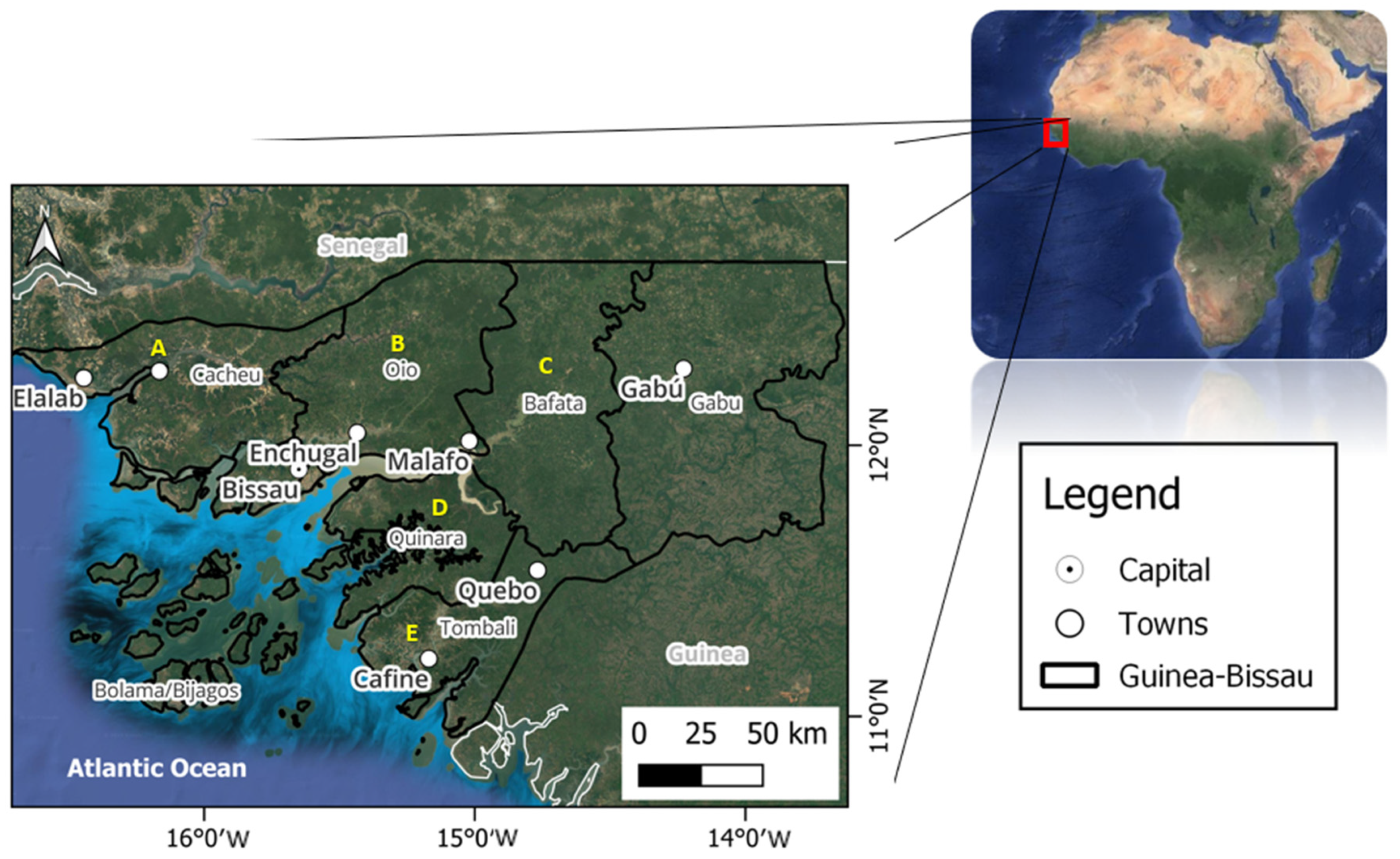
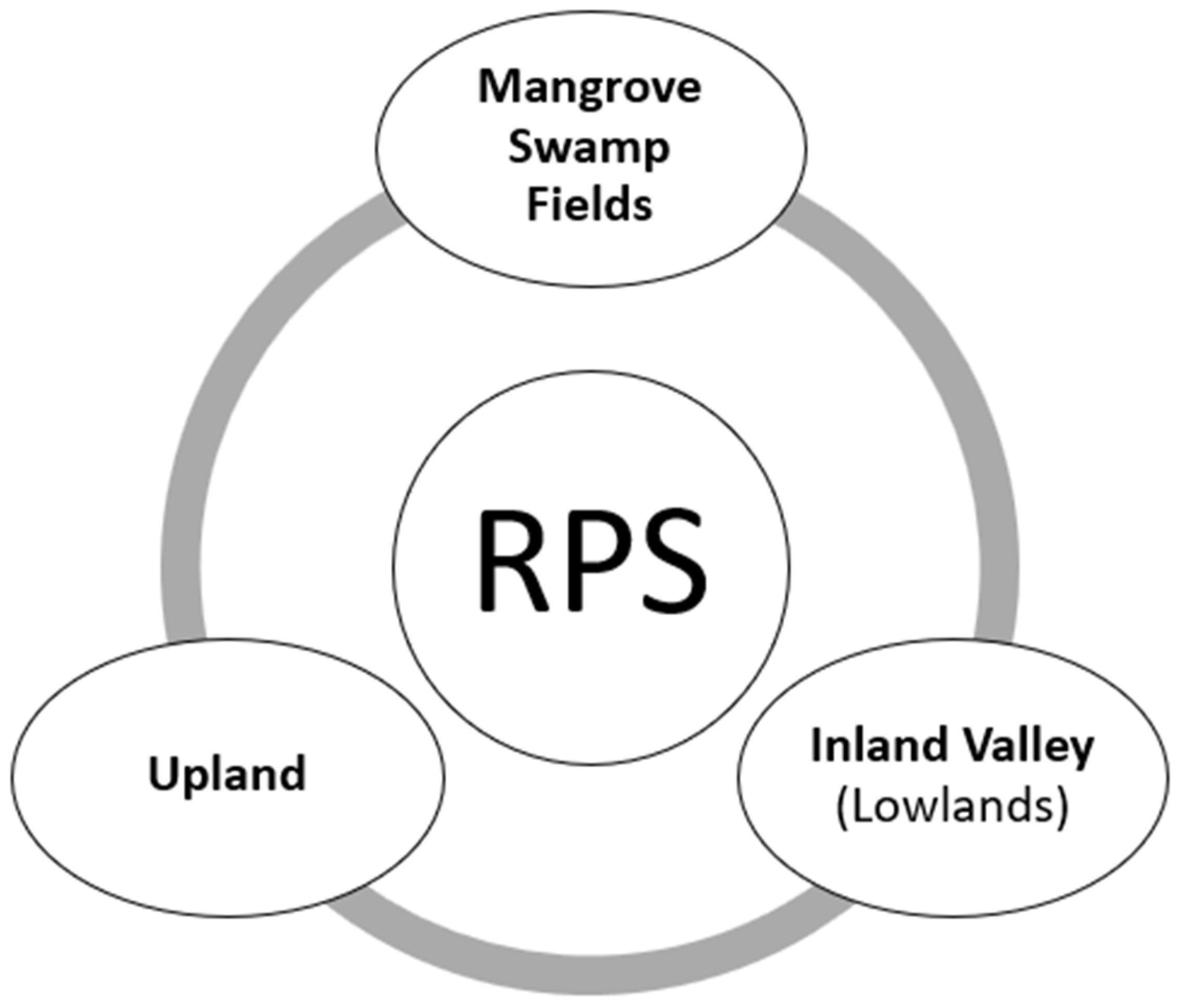
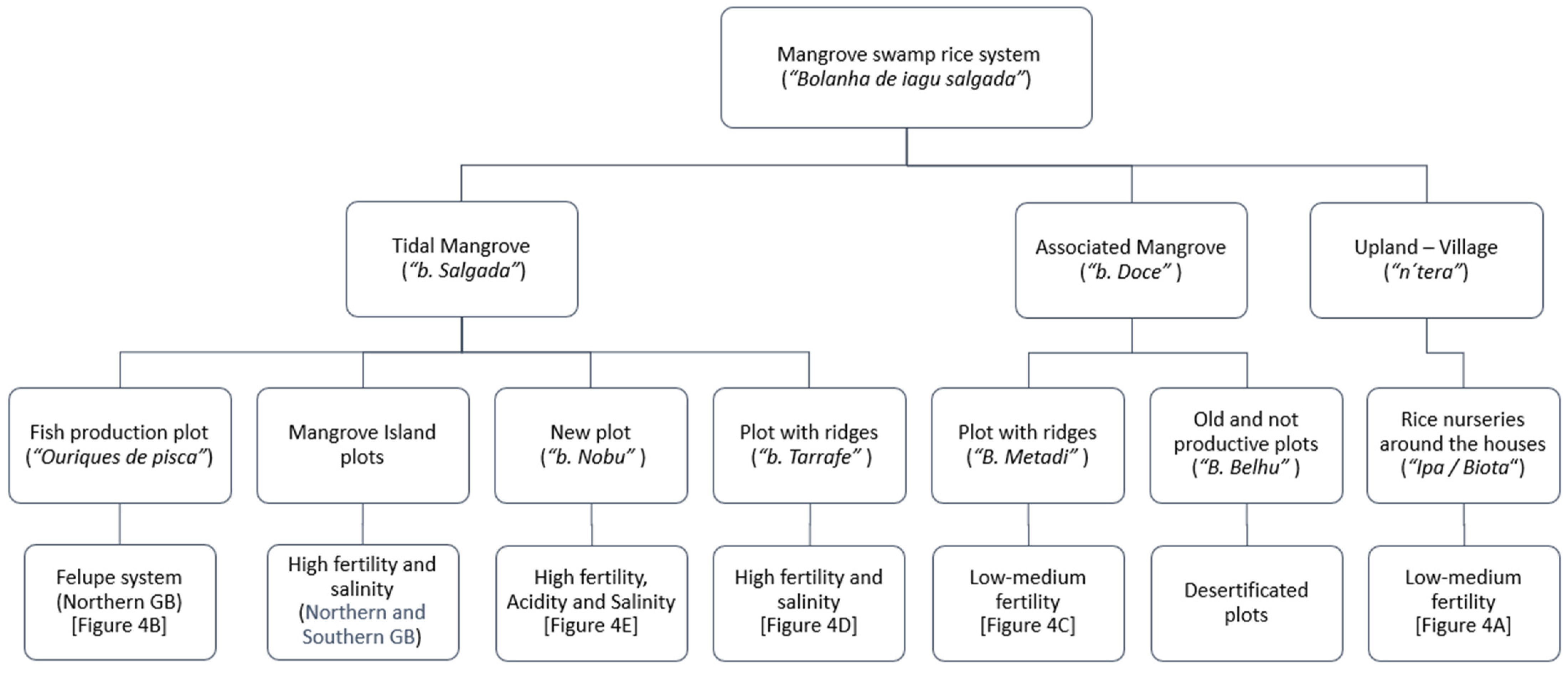
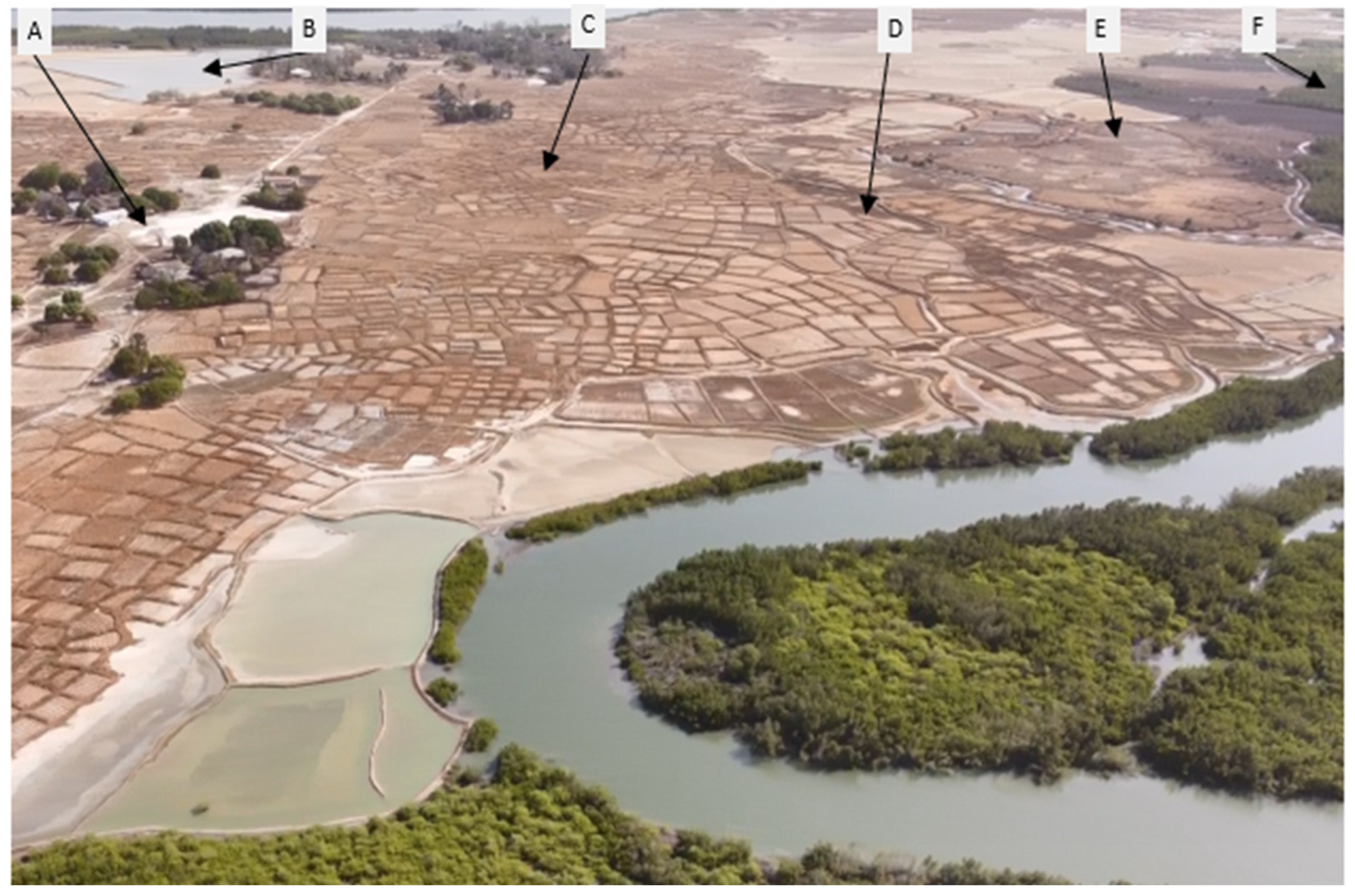

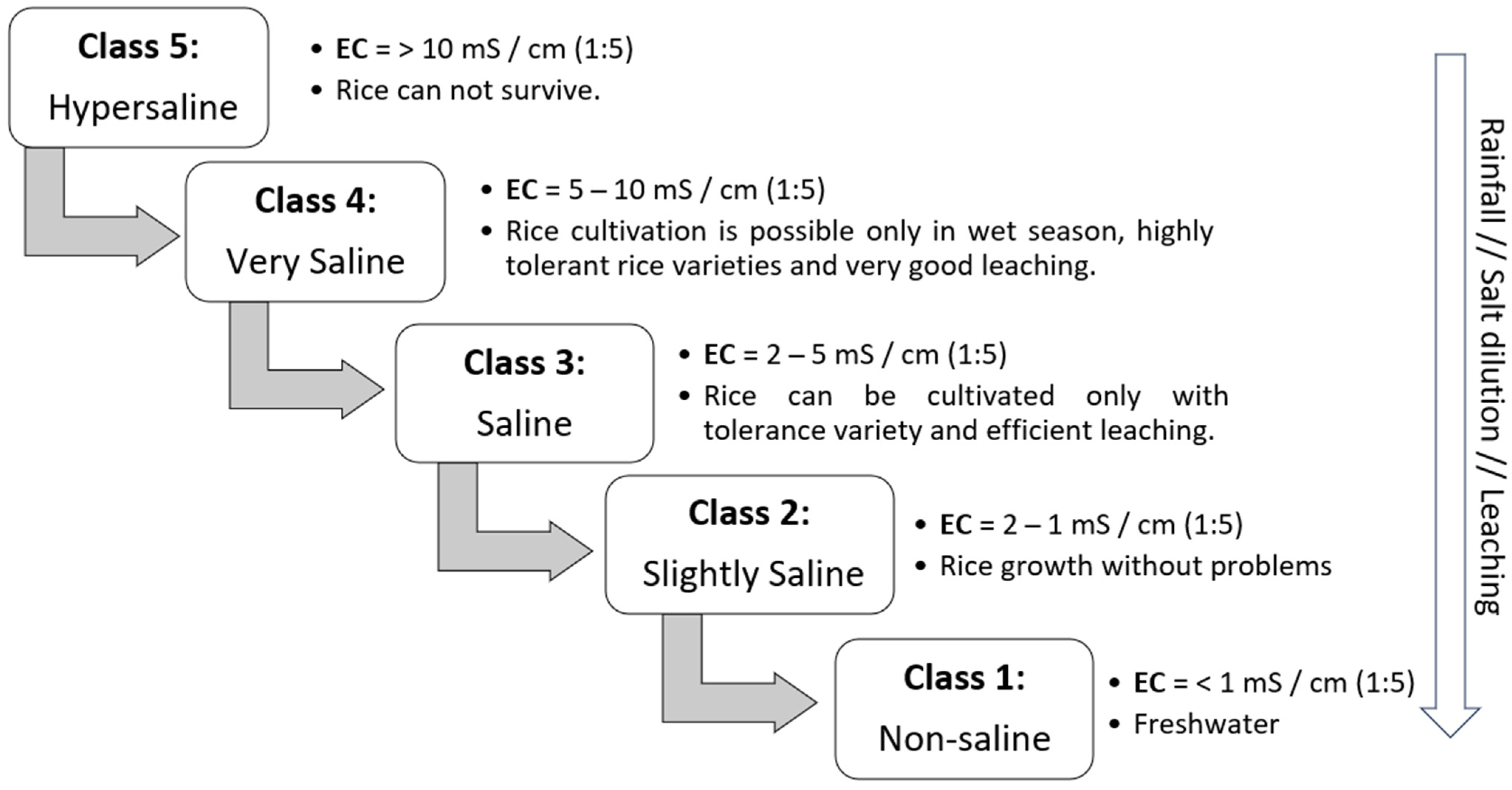
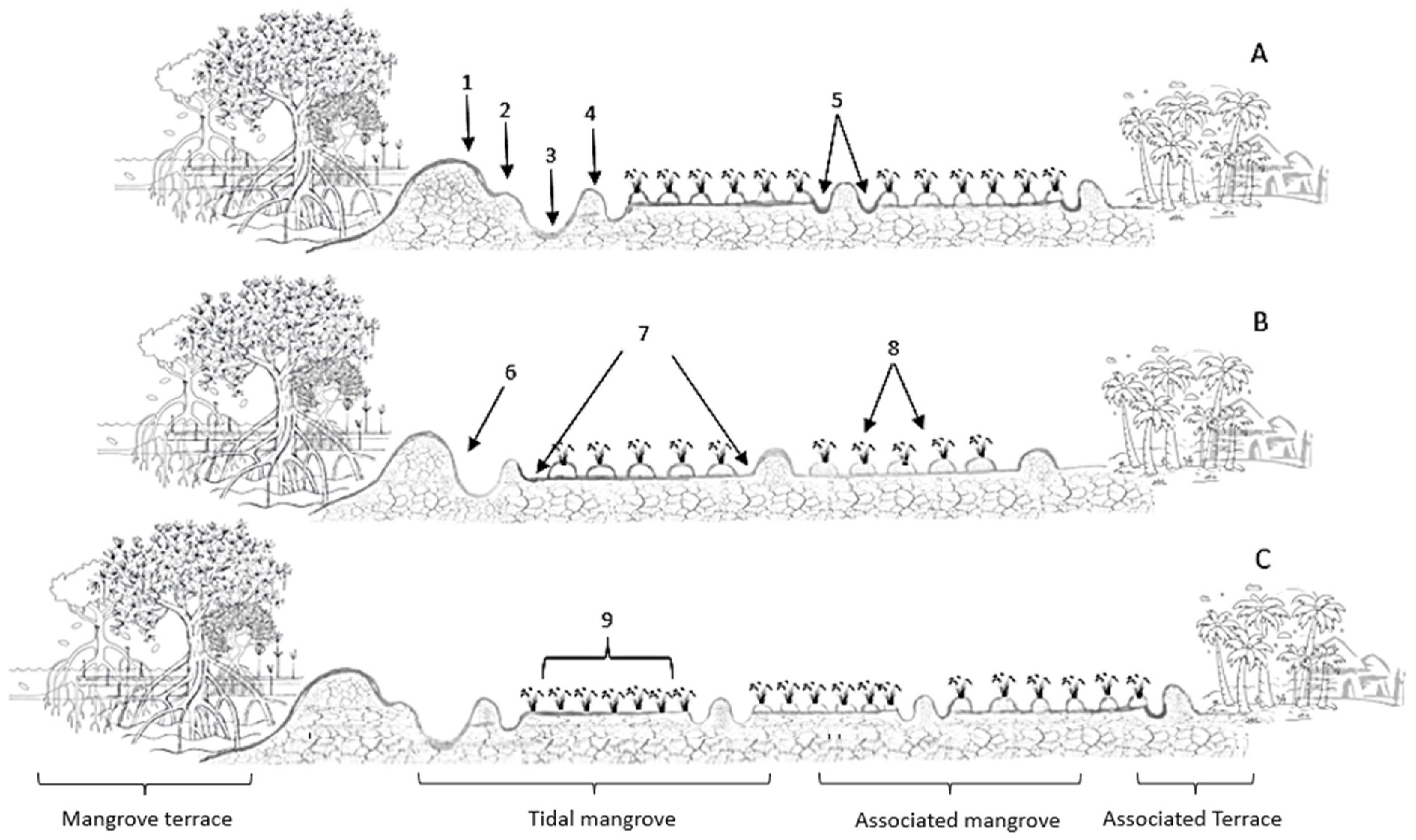
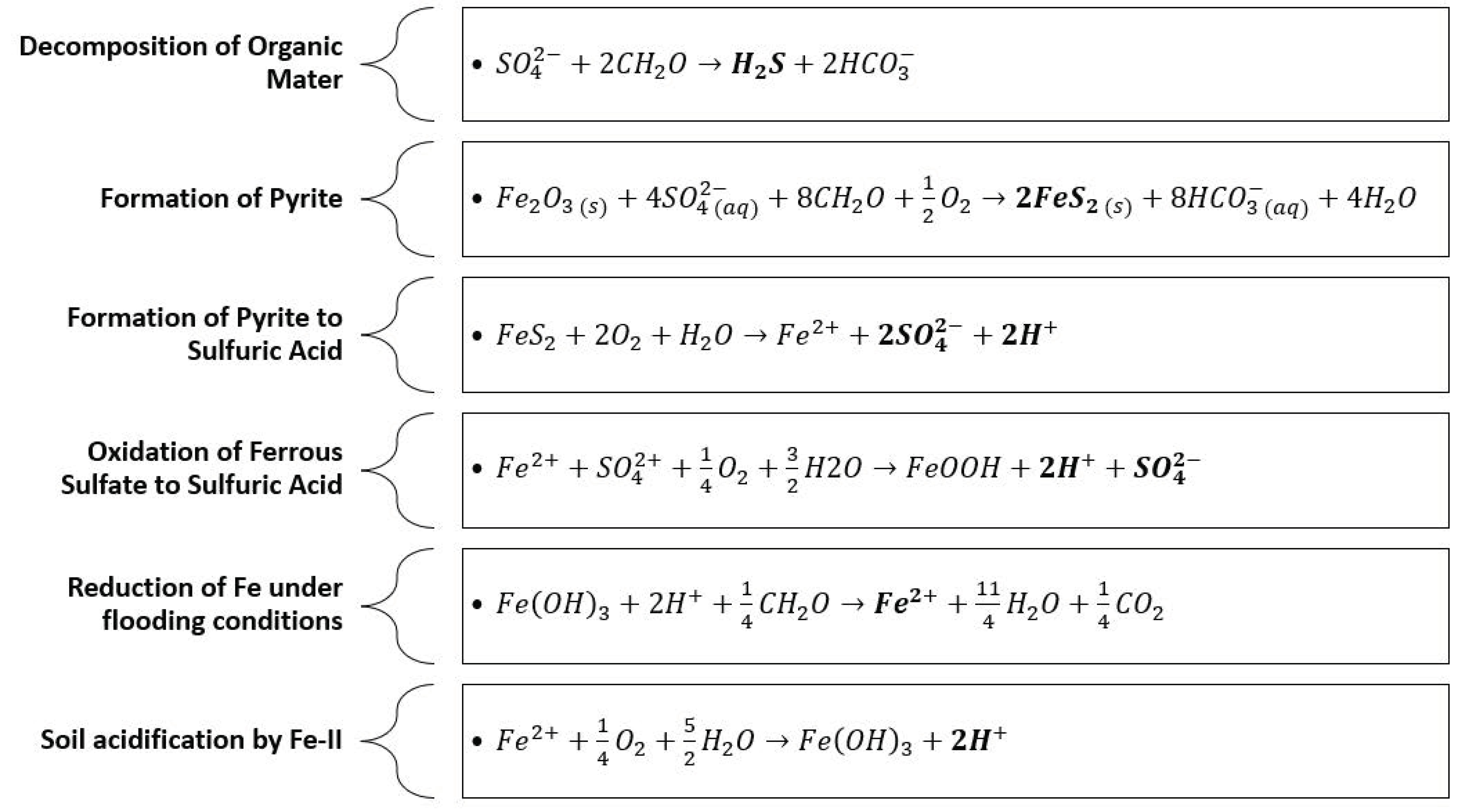
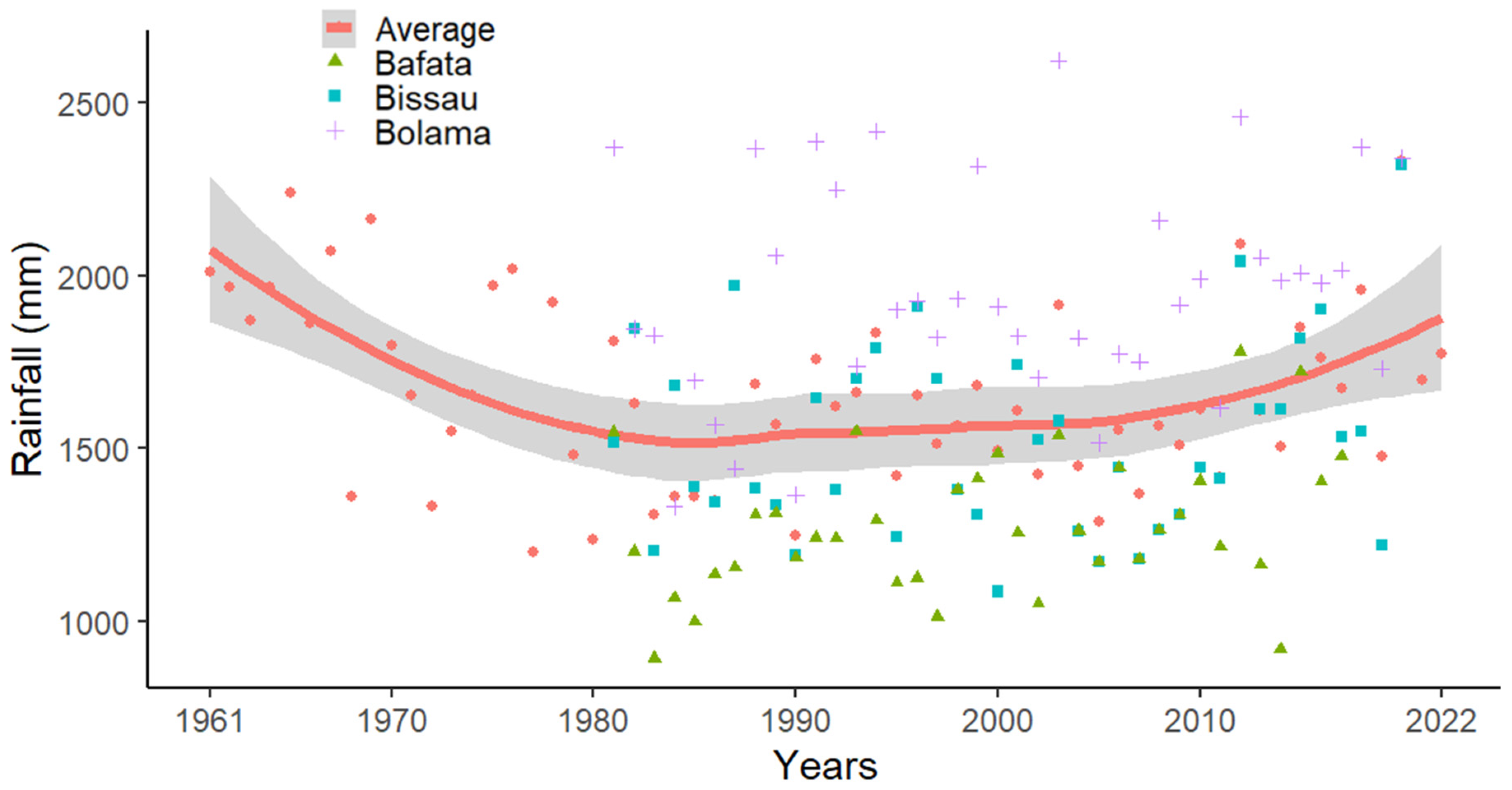
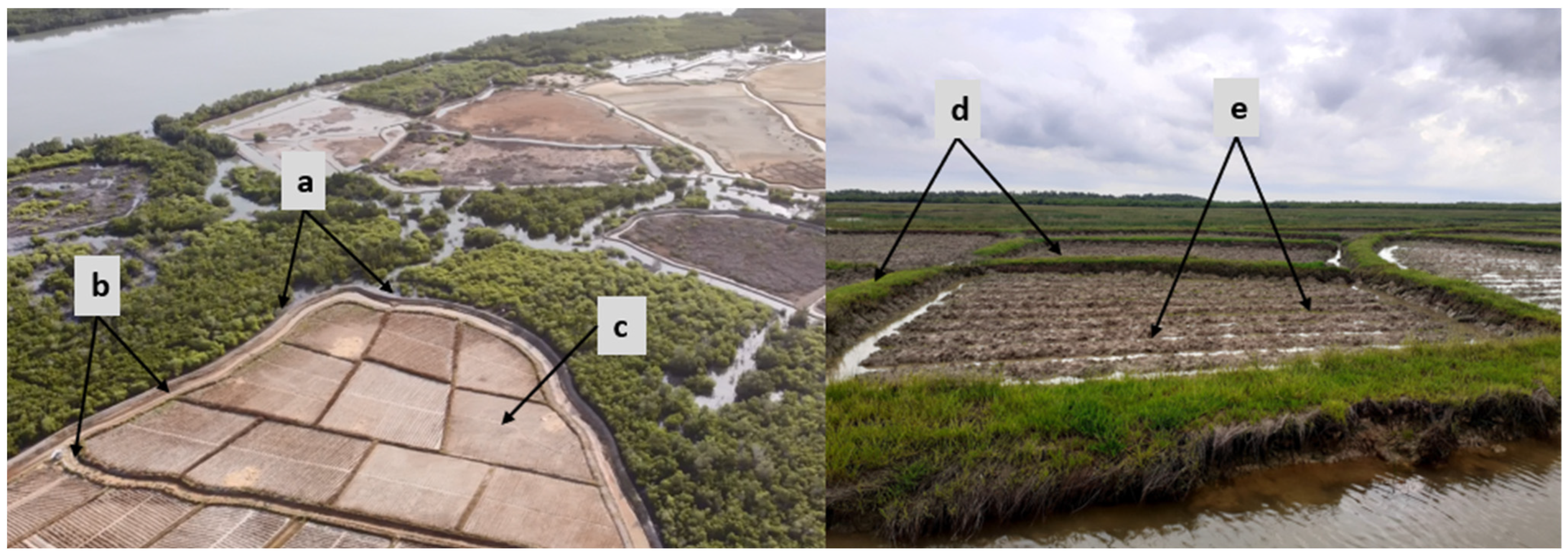
| Year/System | Yield Ranges (kg ha−1) | References | |
|---|---|---|---|
| Upland | MSRPS | ||
| 1947 | - | 2060–3000 | [75] |
| 1948 | - | 1620–2680 | [75] |
| 1949 | - | 1040–1960 | [75] |
| 1953 | 300–600 | 1800–2000 | [54] |
| 1968 | 1098 | 1832 | [54] |
| 1970 | 600–800 | 1000–3000 | [19] |
| 1982 | - | 1900 | [76] |
| 1983 | - | 2700 | [76] |
| 1986 | 270–950 | 1020–3750 | [77] |
| 1987 | - | 1305–2700 | [78] |
| 1988 | - | 1714–3033 | [78] |
| 1990 | 400–600 | - | [79] |
| 1991 | 300–600 | 600–1500 | [18] |
| 1994 | - | 1960 | [76] |
| 1995 | - | 2800 | [80] |
| 1999 | 500 | 1500–4000 | [79] |
| 2001 | 1000 | 3000 | [12] |
| 2008 | 400–800 | - | [20] |
| 2008 | 400–800 | - | [20] |
| 2010 | - | 1584 | [72] |
| 2014 | - | 1700–2600 | [31] |
| 2015 | - | 1120–2870 | [81] |
| 2017 | - | 1000 | [12] |
| 2021 | - | 1600 | [30] |
| 2023 | - | 1180–1910 | [39] |
| Species | History and Adaptability | Phenotypic Characteristics | Genotypic Characteristics |
|---|---|---|---|
| Oryza glaberrima |
|
|
|
| Oryza sativa |
|
|
|
| References | [16,19,21,57,79,80] | ||
| Characteristics | Tidal Mangrove Terrace | Tidal Mangrove Fields | Associated Mangrove Fields |
|---|---|---|---|
| Soil taxonomy (USDA) | Haplic sulfaquents, typic sulfaquents, sulfic fluvaquents, sulfic, hydraquents, sulfohimists, hemists, fibrists. | Histic sulfaquents, hapic sulfaquents, yypic sulfaquepts, sulfic hydraqiuents, tropofibrits, psammaquents, sulfic tropaquepts, typic tropaquepts, aeric tropaquepts, psammaquents. | Pisoplinthic, hypothionic, tidalic, oxygleyic, tropoquepts, endoaquents. |
| Soil taxonomy (WRB-FAO) | Tidalic, oxygleyic, gleysol (clayic, hyposulfidic). | Hypothionic, pisoplintic, oxygleyic, tidalic, gleysol (vertic, drainic, salic, clayic). | Pisoplintic, hypothionic, gleysol (abruptic, loamy, drainic, salic, clayic, vertic). |
| Geochemical conditions | Anoxic | Sub-oxidation | Oxidation |
| Solubility of sulfates and sulfites | High | High–medium | Low |
| Al-Fe2+ toxicity | High | High–medium | Medium–low |
| Na+ | High | High | Medium–low |
| Soil organic carbon | High | High–medium | Low |
| Possible chemical formations | Reduced iron (Fe2+) Iron monosulfide (FeS) Iron disulfide (FeS2) | Iron monosulfide (FeS) Pyrite (2FeS2) Reduced iron (Fe2+) Oxidized iron (Fe3+) Hydrogen (H+) Hydrogen sulfite (H2S) Aluminum (Al2+) Sulfate (SO42−) Sulfites (SO32−) | Pyrite (2FeS2) Hydrogen (H+) Aluminum (Al3+) Oxidized iron (Fe3+) Sodium (Na+) Sulfate (SO42−) |
| References | [59,63,111,117] | ||
Disclaimer/Publisher’s Note: The statements, opinions and data contained in all publications are solely those of the individual author(s) and contributor(s) and not of MDPI and/or the editor(s). MDPI and/or the editor(s) disclaim responsibility for any injury to people or property resulting from any ideas, methods, instructions or products referred to in the content. |
© 2024 by the authors. Licensee MDPI, Basel, Switzerland. This article is an open access article distributed under the terms and conditions of the Creative Commons Attribution (CC BY) license (https://creativecommons.org/licenses/by/4.0/).
Share and Cite
Garbanzo, G.; Cameira, M.d.R.; Paredes, P. The Mangrove Swamp Rice Production System of Guinea Bissau: Identification of the Main Constraints Associated with Soil Salinity and Rainfall Variability. Agronomy 2024, 14, 468. https://doi.org/10.3390/agronomy14030468
Garbanzo G, Cameira MdR, Paredes P. The Mangrove Swamp Rice Production System of Guinea Bissau: Identification of the Main Constraints Associated with Soil Salinity and Rainfall Variability. Agronomy. 2024; 14(3):468. https://doi.org/10.3390/agronomy14030468
Chicago/Turabian StyleGarbanzo, Gabriel, Maria do Rosário Cameira, and Paula Paredes. 2024. "The Mangrove Swamp Rice Production System of Guinea Bissau: Identification of the Main Constraints Associated with Soil Salinity and Rainfall Variability" Agronomy 14, no. 3: 468. https://doi.org/10.3390/agronomy14030468
APA StyleGarbanzo, G., Cameira, M. d. R., & Paredes, P. (2024). The Mangrove Swamp Rice Production System of Guinea Bissau: Identification of the Main Constraints Associated with Soil Salinity and Rainfall Variability. Agronomy, 14(3), 468. https://doi.org/10.3390/agronomy14030468








